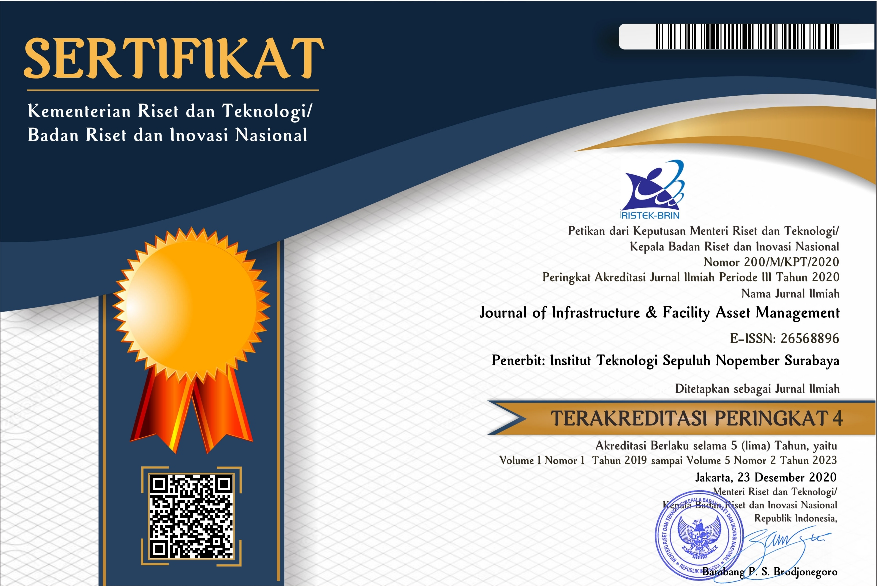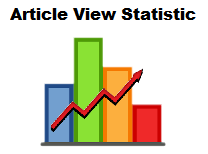The spatiotemporal variable effects of individuals’ CO2 emission in Bandung Metropolitan Areas
Abstract
Full Text:
PDFReferences
Arifwibowo, S.D. (2012). “Exploring the effect of compact development policy on urban quality of life in Bandung”. City, Culture and Society 3: 303-311.
Akar, G., Clifton, K. J, Doherty, S. T (2011). “Discretionary Activity Location Choice: In-home or Out-of-home”. Transportation 38: 101-122.
Beige, S., & Axhausen, K. W. (2017). “The dynamics of commuting over the life course: Swiss experiences”. Transportation Research Part A: Policy and Practice, 104, 179-194.
Boulter, P.G., McCrae, I.S., 2007. ARTEMIS: Assessment and Reliability of Transport Emission Models and Inventory Systems. Final Report. TRL Limited. Wokingham. United Kingdom
Chatterjee, K., Sherwin, H., & Jain, J. (2013). “Triggers for changes in cycling: the role of life events and modifications to the external environment”. Journal of Transport Geography. 30, 183-193.
Cullen, I.G., Godson, V (1975) “Urban networks: The structure of activity patterns”. Progress in Planning 4: 1-96 (1975)
Deendarlianto, W. A., Widodo, T., Handika, I., Chandra Setiawan, I., & Lindasista, A. (2020). “Modelling of Indonesian road transport energy subsector to fulfill the national energy and oil reduction”. Renew Energy, 146, 504-18.
Dijst, M., Farag, S., & Schwanen, T. (2008). “A comparative study of attitude theory and other theoretical models for understanding travel behavior”. Environment and Planning A, 40(4), 831-847.
Dharmowijoyo, D.B.E., Susilo, Y.O., Karlstöm, A. (2015). “Collecting a multidimensional three-week household time-use and activity diary in the Bandung Metropolitan Area”. Transportation Research Part A 80: 231-246.
Dharmowijoyo, D.B.E. (2016) The complexity and variability of individuals activity-travel patterns in Indonesia. Dissertation. KTH Royal Institute of Technology.
Dharmowijoyo, D.B.E., Susilo, Y.O., “Karlstöm, A. (2016). “Relationships among activity duration. travel time spent and activity space indices in the Jakarta Metropolitan Area”, Indonesia”. Journal of Transport Geography 54: 148-160
Dharmowijoyo, D.B.E., Susilo, Y.O., “Karlstöm, A. (2017) Analysing the complexity of day-to-day an individual’s activity-travel pattern using Multi-dimensional Sequence Alignment Method: A case study in Bandung Metropolitan Area”. Journal of Transport Geography 64, 1-12. Indonesia.
Dharmowijoyo, D.B.E., Susilo, Y.O., Karlstöm, A. (2018). “On complexity and variability of individuals’ discretionary activities”. Transportation, 54, 177-204
Dharmowijoyo, D.B.E., Susilo, Y.O., Syabri, I. (2020). “Time use and spatial influence on transport-related social exclusion, and mental and social health”. Travel Behaviour and Society 21, 24-36
Dharmowijoyo, D.B.E., Cherchi, E., Ahmad Termida, N. Samsura, D. A. A (2021) Daily activity-travel pattern, built environment, subjective well-being, and health. Submitted to Transportation
Dharmowijoyo, D.B.E., Susilo, Y.O., Joewono, T.B. (2021) Built environment and health effects on multitasking behaviors and day experiences. Submitted to Transportation Research Part D
Dharmowijoyo, D.B.E., Joewono, T. B. (2020) Mobility and Health: The interaction of activity-travel patterns, overall well-being, transport-related social exclusion on health parameters. Energy Efficiency in Mobility eds S. A. Sulaiman, Springer, Singapore
Ellegård, K., Vilhelmson, B. (2004). “Home as a pocket of local order: Everyday activities and the friction of distance”. Geographycal Annals 86 B (4), 281–296.
Ellegård, K., & Svedin, U. (2012). “Torsten Hägerstrand’s time-geography as the cradle of the activity approach in transport geography”. Journal of Transport Geography, 23, 17-25.
EU (2015). “Priorities”. European Commission.
Available at: http://ec.europa.eu/priorities/index_en.htm
EPA (2019) Fast facts of US transportation sector greenhouse gas emissions 1990-2017. EPA-420-F-19-047, June 2019
ESDM (2012) Ministry of Mineral Resources. Transport Sector, Assessment of Greenhouse Emissions, 2012 (in Indonesia version)
Ewing, R., & Cervero, R. (2010). “Travel and the built environment: A meta-analysis”. Journal of the American planning association, 76(3), 265-294.
Flyvbjerg, B. (2005). “Measuring inaccuracy in travel demand forecasting: methodological considerations regarding ramp up and sampling”. Transportation Research. Part A: Policy and Practice, 39(6), 522-530.
Hägerstrand, T., 1970. What about people in regional science?. People of the Regional Science Association 24, 7–21.
IEA (2016). Decoupling of global emissions and economic growth confirmed. 16 March 2016. International Energy Agency, Paris Internet: https://www.iea.org/ newsroom/news/2016/march/decoupling-of-global-emissions-and-economic-growth-confirmed.html.
Irawan, M.Z., Belgiawan, P. F., Tarigan, A. K. M., & Wijanarko, F. (2019). “To compete or not compete: Exploring the relationships between motorcycle-based ride-sourcing, motorcycle taxis, and public transport in the Jakarta metropolitan area”. Transportation. https://doi.org/10.1007/s11116-019-10019-5
ITF (2017). “Transport outlook”. dx.doi.org/10.1787/9789282108000-en
Jones, H., Moura, F., & Domingos, T. (2014). “Transport infrastructure project evaluation using cost-benefit analysis”. Procedia-Social and Behavioral Sciences, 111, 400-409.
Kang H., Scott D.M. (2010). “Exploring day-to-day variability in time use for household members”. Transportation Research Part A, 44, 609-619
Lanzendorf, M. (2003). “Mobility biographies: A new perspective for understanding travel behaviour”. In Paper presented at the 10th International Conference on Travel Behaviour Research. Lucerne, August 2003.
Lanzendorf, M. (2010). “Key events and their effects on mobility biographies: The case of childbirth”. International Journal of Sustainable Transportation, 4: 272-292.
Liu C., Susilo, Y. O., Kärlstrom, A. (2016). Estimating changes in Transport emissions due to changes in weather and climate in Sweden. Transportation Research Part D 49, 172-187
Liu, C., Susilo, Y.O., Dharmowijoyo. D.B.E (2018). “Investigating intra-household interactions between individuals time and space constraints”. Journal of Transport Geography 73, 108-119
Manoj, M., Verma, A. (2017) “A structural equation model-based analysis of non-workers’ activity-travel behaviour from a city of a developing country”. Transportation 44, 241–269.
McNally, M. G. (2000). The activity based approach. Handbook in Transport (pp. 53 70).
Meloni, I., Guala, L., Loddo, A. (2004). “Time allocation to discretionary in-home, out-of-home and to trips”. Transportation 31: 69-96.
PBL (2016). Trends in global CO2 emissions. Report. Netherlands Environmental Assessment Agency.
Rahman, N. A., Shamsuddin, S., & Ghani, I. (2015). “What makes people use the street?: Towards a liveable urban environment in Kuala Lumpur city centre”. Procedia-Social and Behavioral Sciences, 170, 624-632.
Rizki, M., Joewono, T.B., Dharmowijoyo, D.B.E., Belgiawan, P. F. (2021). “Does multitasking improve the travel experiences of public transport users? Investigating the activities during commuter travels in Bandung Metropolitan Areas, Indonesia”. Public Transport 1-26
Saputra, O., Deendarlianto, D., & Suhanan, S. (2017). Potensi Penurunan Emisi Gas Rumah Kaca Pada Program “Biofuel Mandatory” Sektor Transportasi Darat di Provinsi Jambi.
Schwanen, T., Kwan. M.P., Ren. F. (2008) “How fixed is fixed? Gendered rigidity of space-time constraints and geographies of everyday activities”. Geoforum 39, 2109-2121
Setiawan, I. C. (2021). “Quantitative analysis of automobile sector in Indonesian automotive roadmap for achieving national oil and CO2 emission reduction targets by 2030”. Energy Policy 150, 112135.
Sukarno I., Matsumoto, H., Susanti, L. (2016). “Transportation energy consumption and emissions: A view from city of Indonesia”. Future Cities and Environment 2: 6, DOI 10.1186/s40984-016-0019-x
Suprayitno, H. & Soemitro, R.A.A (2018). ”Pleliminary Reflexion on Basic Principle Infrastructure Asset Management”. Jurnal Manajemen Aset Infrastruktur & Facilitas – JMAIF 2(1) Maret 2018.
Susilo, Y. O., & Dijst, M. (2010). “Behavioural decisions of travel time ratios of work, maintenance and leisure activities in the Netherlands”. Transport Planning and Technology, 33(1), 19-34.
Susilo, Y. O., & Kitamura, R. (2005). “Analysis of day-to-day variability in an individual's action space: exploration of 6-week Mobidrive travel diary data”. Transportation Research Record, 1902(1), 124-133.
Susilo, Y. O., & Maat, K. (2007). “The influence of built environment to the trends in commuting journeys in the Netherlands”. Transportation, 34(5), 589-609.
Susilo, Y.O., Stead, D., (2009). “Individual carbon dioxide emissions and potential for reduction in the Netherlands and the United Kingdom”. Transportation Research Record 2139, 142–152. http://dx.doi.org/10.3141/2139-17. United Kingdom
Susilo, Y., & Avineri, E. (2011). “The impacts of household structure to the day-to-day variability of individual and household stochastic travel time budget”. In The 43rd UTSG Annual Conference. Milton Keynes, UK. 5-7 January 2011.
Tarigan, A.K.M., Sagala, S., Samsura, D.A.A., Fisabilillah, D.F., Simarmata, H.A., Nababan, M. (2016). “Bandung City. Indonesia”. Cities 50, 100-110.
Van Acker, V., Van Wee, B. & Witlox, F. (2010). “When transport geography meets social psychology: Toward a conceptual model of travel behaviour”. Transport Reviews, 30(2), 219-240.
Van Acker, V., Goodwin, P. & Witlox, F. (2016). “Key research themes on travel behaviour, lifestyle and sustainable urban mobility”. International Journal of Sustainable Transportation, 10(1), 25-32.
Verma, A., Verma, M., Sarangi, P., Yadav, V., & Manoj, M. (2021). “Activity participation, episode duration and stop-making behavior of pilgrims in a religious event: An exploratory analysis”. Journal of Choice Modelling, 38, 100267.
Waygood, E. O. D., Sun, Y., & Susilo, Y. O. (2014). “Transportation carbon dioxide emissions by built environment and family lifecycle: Case study of the Osaka metropolitan area”. Transportation Research Part D: Transport and Environment, 31, 176-188.
Wicaksono, A., Dharmowijoyo, D.B.E., Tanjung, L.E., Susilo, Y.O. (2021) “The reciprocal effects of online activities and physical activities and the use of ride-sourcing mode on health”. Submitted to Transportation Research Part A
Worldometers (2020) https://www.worldometers.info/
DOI: http://dx.doi.org/10.12962%2Fjifam.v4i1.14300
Refbacks
- There are currently no refbacks.
Visitor :
Flag Counter

Journal Of Infrastructure & Facility Asset Management by Institut Teknologi Sepuluh Nopember is licensed under a Creative Commons Attribution-ShareAlike 4.0 International License.





